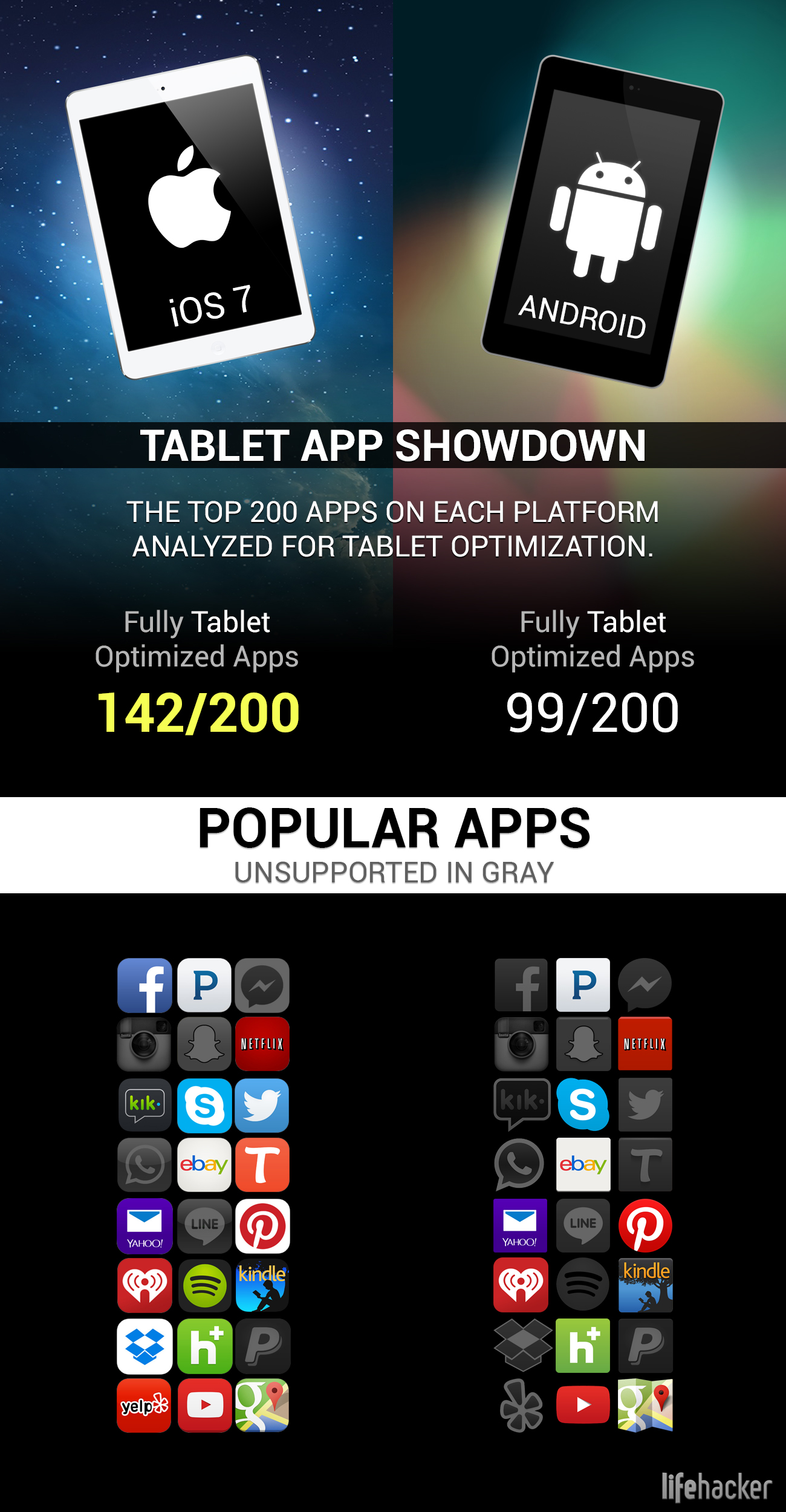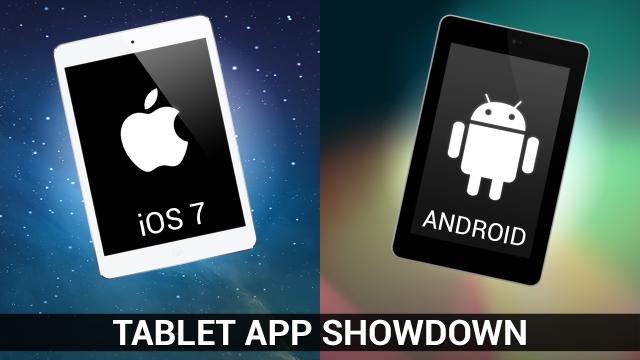Android and iOS both have mature app stores when it comes to phones. Support for tablets, however, are still evolving. We decided to take a look at how far tablet support on both platforms have come over the last three to four years of development.
Methodology
Analysing tablet app support requires a little bit of subjectivity. For starters, tablet “support” means two different things on iOS and Android (which we’ll explain in a bit). Secondly, getting a cross-section of the most used apps is complicated. For our analysis, we looked at the top 200 apps on both iOS and Android as reported by App Annie (for a total of 400 apps). However, there are a few categories that we excluded at our own discretion:
- Irrelevant apps: Some apps do not have or need tablet support. Apps like flashlights or individual widgets don’t necessarily need have dedicated tablet interfaces. For this reason, some popular apps were ignored.
- Junk apps: 50 million people may download a ringtone maker, but the Amazon tablet app with five million downloads is arguably more important. We did not include apps like horoscopes, task killers and ringtone makers in our analysis.
- Phone-specific apps: Certain app functions aren’t usable on tablets anyway. While we included messaging apps and services that are primarily geared towards phones but can be used on tablets, we excluded things like caller ID apps that don’t have a usable function on tablets.
- Games: Not only are games outside of our primary area of concern here at Lifehacker, most games developers tend to build their own UIs from scratch anyway. Supporting tablets for games more often involves including high-res assets rather than adopting a substantially different UI for increased screen real estate.
So, what results is less of an official “Top 200” list and more of a “list of popular apps” as compiled by our experience and best judgement.

A Word On Android App Support
Determining Android tablet compatibility is a bit more nuanced than it is on iOS. The way Android handles app UI accounts for many different screen sizes, so the interface elements can automatically fill in the space available. For example, while a list of contacts might only show four or five names at a time on a phone, you’ll be able to see seven or eight on a tablet — even if the app hasn’t been “optimised”, On the iPad, it would just blow up the iPhone version so that you’d see the same number of contacts — they’d just be bigger (and lower resolution).
This scaling means that some apps work sufficiently enough on a larger screen. Twitter, as an example, makes much more effective use of the 7-inch display of the Nexus 7. Twitter has done nothing to optimise it for a tablet interface, and it could arguably be better, but the owner of a 7-inch tablet would likely find that Twitter’s “support” for tablets is good enough.
However, 10-inch Android tablets tend to fall into this category less often because most larger Android tablets are designed to be used in landscape mode, as opposed to the portrait mode that phones and 7-inch tablets use. For this reason, we split Android tablet support into three categories:
- Full support: These apps have UIs that are specifically designed to take advantage of the extra space on both 7-inch and 10-inch tablets. Arguments about whether it’s a good UI are one thing (as with any app), but in these cases the developer at least made an effort.
- Partial 10-inch support: Apps that are flagged for both portrait and landscape mode and aren’t completely horrible fit into this category. As an example, Facebook Messenger would be included because, while stretched wide, conversations are readable. Instagram, however, would not be included because it does not allow nor support any landscape orientation.
- Partial 7-inch support: Apps that can be used in portrait mode on 7-inch displays are placed in this category. Some of them may be locked into a phone-oriented UI with oversized buttons, while others may scale to appropriate sizes but only be usable in portrait mode and the app won’t rotate to landscape.
- Unsupported: Apps that cannot be installed on tablets in either category via the Play Store are deemed unsupported and are not included in any category. It may be possible to force install an app via sideloading, but we did not include these apps.
When we account for these distinctions we get a more complex data set:
While we only included explicitly supported tablet apps in our graphic at the top of this post, if you include partial tablet support, Android does considerably better — at least when it comes to raw numbers.
Conclusions
The most obvious conclusion we can draw from all this data is that if you’re looking for the most dedicated tablet support, the iPad is the way to go. Out of the 200 iOS apps surveyed, 71 per cent were specifically updated to support tablets. Android had 99, or about 49.5 per cent. Less than half of the 200 most popular Android apps were optimised for tablets.
However, due to the subjective nature of what constitutes “support”, you may not care that this number is so low. If we include apps that have partial support for 10-inch tablet interfaces, the numbers get more comparable. 141 of the 200 apps (70.5 per cent) are at least usable. That number goes up to a surprising 187 out of 200 (93.5 per cent) if you’re using a 7-inch tablet and don’t mind apps that are stretched out a little.
The bigger problem with Android’s app support is not necessarily the number of apps supported, but the quality. As you can see in the infographic above, big name apps like Facebook and Twitter have still not rolled out universal tablet interfaces for their apps (Note: Twitter did create a tablet-oriented interface for Samsung tablets back in October, however the interface hasn’t made it outside of certain exclusive devices).
Whichever route you choose, your personal use case and preferences are going to determine how much you care about tablet support. If you want a 7-inch tablet with a little more reading room, you won’t have a significantly worse experience on either platform. If you want a 10-inch tablet and white space is your mortal enemy, you should probably stay in Apple’s camp.

Comments
7 responses to “iOS Vs Android: Which Platform Has Better Tablet Support?”
Will you be adding Windows 8 tablet to this mix anytime soon? I do think that it has an edge for business over the other tablets.
As the owner of three Android tablets (A500, N7 2012, N10), and knowing several others who have iPads, the iPad certainly has better tablet support. Not only that, it often still seems to have apps that are of better quality and the hardware support is longer.
I love my Android tabs, but that’s because I use Android a lot and experiment with OS mods and so on. If you just want a tablet to use, and are choosing between an iPad or Android tablet, get an iPad.
That said, if you want a tablet which is actually a real computer then the Microsoft (i-x based, not ARM based) tablets are the way to go.
Don’t you have to pay for specific iOS tablet apps separately to the phone version? If so, you would want better support! I have a Nexus 4, Nexus 7 and Samsung Note 10.1 and it is a tiny bit annoying that some apps don’t scale well between them. Hell, I’ve even got some old apps that haven’t even been optimised for modern 5″ phones – they look best on a 3.5″ screen. One thing I like about my Samsumg is the multi-window support. It’s like having 2 7″ screens side-by-side.
Re: Paying for iPad versions – In a word: No. *Some* apps haveiPad only versions, but the majority (good ones) run on both phones & tables and scale accordingly.
IMO the fact that the Android platform has widgets and customisable homescreens means that the functionality of the actual homescreens of Android tablets is far ahead of the iPad, which is just restricted to a large grid of icons. The greater screen real estate on tablets means this disparity is even greater than between Android phones and the iPhone.
I just bought my first Android device (a Galaxy Note 8) and love the widgets. I don’t need many but they make the device even more useful than I imagined.
Now I have a Windows 8 ultrabook/tablet, an Android and an iPhone. They interoperate quite well since I’m basically sharing data via email and cloud sharing, and the Android device syncs with Windows iTunes much better than my iPhone. OK that’s a low quality bar to jump.
I’ve only bought one Play app as pretty much everything else I use is free.
The lesson is that I’m much less captured by my iOS app purchases than I thought. Being free of iTunes might easily compensate for any shortcomings elsewhere.
I have to agree with you, I had to buy an ipad for work and i hate the interface – it just seems so old